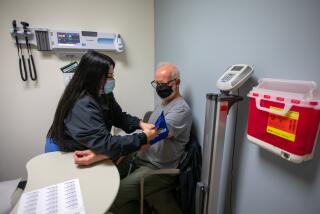Smart Medicine : Does just the mere <i> thought</i> of going in for a checkup make you ill? Don’t fret. More and more doctors are going out of their way to soothe patients’ fears.
- Share via
Three-year-old Sammy Schiffer is poised on top of the salmon-colored elephant, his tongue between his teeth for concentration. Gingerly, he slides down the plastic trunk, looking pleased with himself.
It’s hard to believe the blue-eyed toddler is at the doctor’s office for a follow-up look at his sore throat. The atmosphere, like his attitude, is far from grim.
But then, this office looks more like a playroom. Besides the elephant that doubles as an exam table, there is an array of toys and a gum ball machine full of tiny prizes that accepts “GoodPatient” tokens instead of coins.
As medicine becomes increasingly complicated--and physicians worry about what the future may bring--some doctors are taking a page from the past: A comfortable patient, they realize, is a happy patient.
And volumes of research back up their claim. The more relaxed a patient, the more receptive to treatment--and sometimes the speedier and more comfortable the recovery, studies show.
*
“I’m not trying to make it Disneyland,” says Dr. Terri Rock, a Santa Monica family practice physician. But she believes that making a medical office a friendly milieu can go a long way toward lifelong good health habits.
“I have adult patients who have neglected routine checkups,” Rock says. “They always trace it back to when they were kids. They remember being held down when they got shots.” Or they recall an examination table that seemed as high as the sky.
But Rock’s young patients can’t wait to scramble to the top of her elephant exam table. Once settled, they don’t have to tense up in anticipation over an ice-cold stethoscope. Rock warms hers with a special heat pack. If patients need an immunization, Rock first applies an anesthetic cream or uses a needleless applicator.
The techniques and kid-friendly furniture reflect genuine concern, says Carol Osborne, who with her 4-year-old son, Harry Fukano, is a longtime patient. When they visit, she says, “We feel like we’re her favorite patients. He looks at Dr. Rock as someone to play with. He never balks at going. He knows there will be trains, books and toys.”
A county away, Dr. Richard Hansen of Fullerton has his work cut out for him: helping patients tolerate a dentist’s office. At the crux of Hansen’s anxiety-reduction plan is the premise that “most people don’t like losing control of their environment”--least of all during a root canal or a filling.
So his chairs are equipped with “patient comfort control” buttons. (“Please don’t call it a panic button,” Hansen pleads.)
No matter how fast the drill is going--or what instrument is being poked around--a single push of the button on top of a cylindrical unit held by the patient stops everything.
“I’ve had other dentists tell me, ‘You’re crazy, they’ll abuse it,’ ” says Hansen, who is applying for a patent on the device and hopes to market it to colleagues. “I’ve only had someone push it once in two years.”
Hansen estimates he has spent about $100,000 so far making his office patient-friendly, including a “virtual viewing system” for movies. But one of his best anxiety-reducing techniques requires simple thoughtfulness: His office staff isn’t allowed to discuss procedures within earshot of waiting patients.
*
Creating a relaxed environment for patients is smart medicine, a spate of studies suggest.
When University of Connecticut researchers evaluated 42 women about to undergo periodontal surgery, they found that the more depressed, anxious and fatigued the women were before surgery, the more likely they were to report postoperative pain.
Reducing the anxiety associated with childhood injections is more important than some doctors might realize, Dr. Linda Rice, a Washington, D.C., anesthesiologist, writes in the Journal of Pediatrics.
In a survey, Rice says, 65 of 119 children called injections or needles more hurtful than anything else. Among other measures, she recommends doctors not tell patients that an injection will not hurt.
Other researchers have found that cardiac patients given a chance to ask questions about their individual concerns about recovery were less anxious than those in traditional staff-directed educational programs.
*
As nurse practitioner Corrine Woo begins a pelvic exam, she suggests that her patients lie back on the exam table and relax. Once their eyes fix on the ceiling, few can suppress a grin.
Staring back at them is Mel Gibson from a poster promoting “Forever Young.”
“I’d been thinking about doing this for years,” says Woo, who began the poster experiment a couple of months ago when a colleague at Kaiser Permanente, Woodland Hills, was about to discard the poster.
“This morning, a woman in her 70s was in, and was tense,” says Woo, who told her, “You can gaze into Mel Gibson’s blue eyes.”
“I’m doing that, I’m doing that,” the patient, by now smiling, replied.
Men can be just as reluctant at the doctor’s office.
Dr. Cappy Rothman, founder of the California Cryobank and staff andrologist at Century City Hospital, has learned how to help men relax, even when the procedure or exam might provoke more than the usual anxiety.
Over at his sperm bank in Westwood, a hallway is decorated with photos of men with babies. And when a patient visits his office to produce a specimen to evaluate infertility or vasectomy reversal, for instance, Rothman offers use of a special exam room with a deadbolt on the door.
Privacy is one way to relieve anxiety, agrees Dr. Mark Vogel, a West Los Angeles urologist and USC assistant clinical professor of urology. So is creating an unhurried environment. “We try not to rush patients through procedures,” he says.
If a procedure requires use of an endoscope to view the urethra or bladder, for example, he is careful to give the local anesthetic plenty of time to take effect before beginning. “We explain why we need to do a test, the rationale,” he says. “And we tell patients to take their time [getting ready].” With such reassurance and explanations, Vogel says, “They’re a lot less uptight. If patients are uptight, it can be a lot more uncomfortable.”
*
At Orthopaedic Hospital, Dr. M. Mark Hoffer is beginning his rounds at the afternoon clinic. He looks official in his starched white coat. But once he goes to work, galloping from exam room to exam room, it’s easy to see how his body language and words help him forge a bond with his young patients.
In the first room, he stoops down so the 19-month-old sitting in a baby carrier can play with his face and glasses and then dispenses a pearl of wisdom to the residents surrounding him.
“Always get lower than them,” he says. “Play with their feet.” Avoid traditional exam tables, he suggests. “When you put them up on a high table like that, it scares the hell out of them. The best exam table is a mother’s--or father’s--lap.”
In another room, Rigoberto Franco, a handsome 9-year-old with a fresh scrubbed face, is waiting with his mother, Olga. He fell while carrying a glass vase and cut his elbow. On this follow-up visit, Hoffer tells Rigoberto he is healing nicely, then turns and repeats the entire assessment in Spanish to his mother.
He repeats the process in another exam room. The parents, who aren’t fluent in English, look pleased when Hoffer fills them in, but the native New Yorker is self-deprecating. “I wish I was more fluent,” says Hoffer later, who remembers what he can from school Spanish classes. “My parents wanted me to take Latin, and I said, ‘That’s silly. I want to know what the guy down the block’s saying.’ ”






